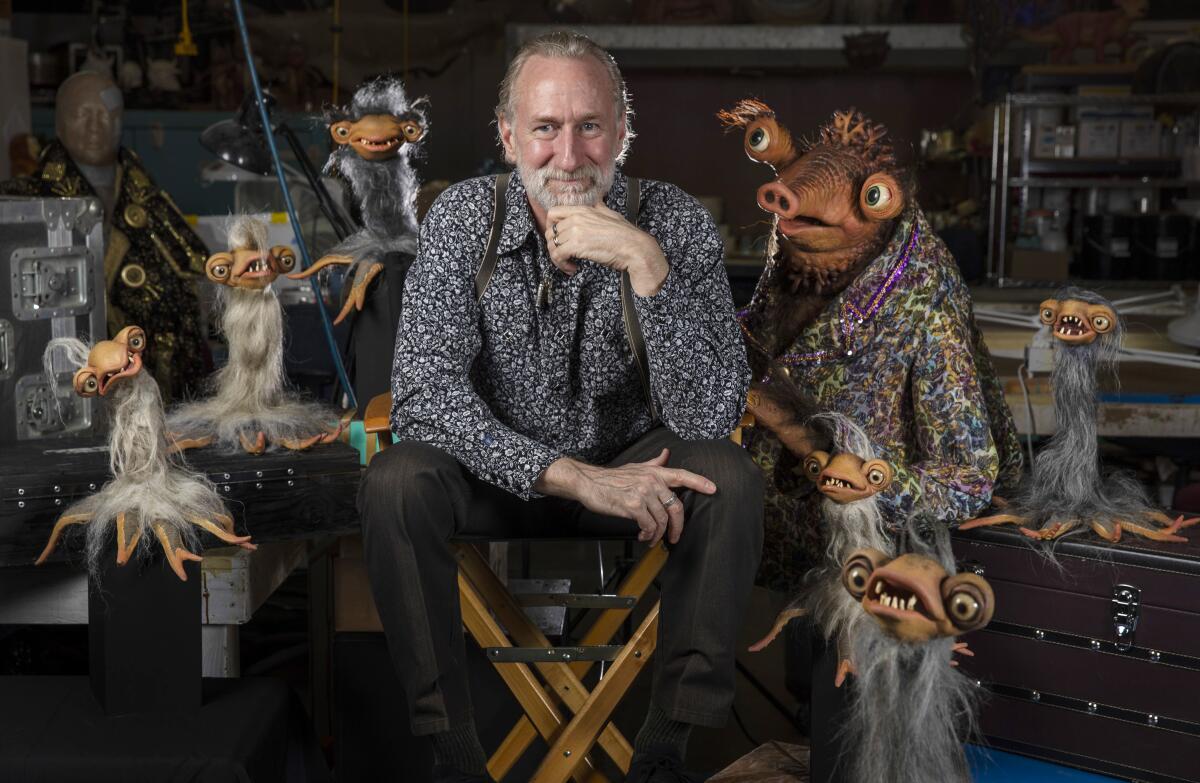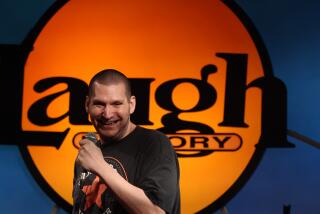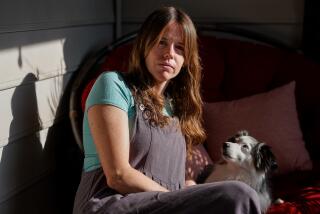It might be Hollywoodâs toughest role to land. And heâs in charge of auditions

The Jim Henson Co. is having a busy pandemic.
Ten new episodes of the Disney+ series âEarth to Ned,â a semi-improvised talk show hosted by a big puppet alien â and one of this writerâs favorite series of 2020 â launched in January. As of last week, Disney+ also hosts Hensonâs prehistoric, satiric family sitcom from the early 1990s, âDinosaurs,â a sort of puppet Flintstones minus the humans, with â imagine that this is a rooftop and I am shouting from it â all five seasons of âThe Muppet Show,â the foundation of modern Muppet mythology, following Feb. 19. (Disney has owned the âMuppet Showâ Muppets since 2004.) Meanwhile, there are new âFraggle Rockâ shorts streaming from Apple TV+ and an upcoming Discovery+ cooking-for-kids show, âDuffâs Happy Fun Bake Time,â featuring celebrity pastry chef Duff Goldman and puppet friends. And another strand of the Henson legacy is examined in a new documentary, âStreet Gang: How We Got to Sesame Street.â
After the death of Jim Henson in 1990, the company remained very much a family affair: Brian Henson is its chairman; sister Lisa is CEO and president; and sister Cheryl is the president of the grant-dispensing Jim Henson Foundation. After various school-break odd jobs on Muppet projects, Brian went to work on Walter Murchâs âReturn to Oz,â where he puppeted Jack Pumpkinhead, and âLittle Shop of Horrorsâ for director Frank Oz, as a principal performer of the big carnivorous flower, Audrey II, before going to work for his father training and directing background puppeteers on the movie âLabyrinth.â
Later he would direct the beloved âMuppet Christmas Carolâ and âMuppet Treasure Island,â as well as the less cherished âHappytime Murders,â and act as executive producer on myriad series for children and/or adults, from âBear in the Big Blue Houseâ to âDinosaursâ to âFarscapeâ to âNo, You Shut Up!â to âEarth to Ned.â But perhaps the most telling thing I can say about him is that in the course of a recent 45-minute conversation over video conference, to talk about âNedâ and growing up Henson, he used the word âdelightâ or âdelightfulâ no less than 11 times.
In âEarth to Ned,â from the Jim Henson Company and Disney+, an alien sent to invade Earth instead falls in love with it, and hosts a talk show.
One surprising thing about âEarth to Nedâ is how well it works as an actual talk show.
I like to say that when we at the Henson company pitch a show, thereâs always some aspect we have no idea if itâs possible. Weâve always believed a normal Muppet-style hand puppet can handle an improvising environment, but with animatronics, there are multiple performers integral to the performance. Ned has six puppeteers: one voicing and operating the mouth, one operating the rest of the face, which is like 30 or 40 motors. Then thereâs a puppeteer inside working the body and the head position. And then there are three doing the hands. And the rule in our company is that that kind of character cannot improvise and shouldnât ever do talk show appearances and stuff like that. We were promising basically the thing we had ruled impossible.
We had to program into Nedâs personality that heâs a little bit out of control. We said, âIf he were a person heâd be one of those people that if you had him over for dinner, you wouldnât put any stem wine glasses near him.â And the guests really enjoyed being in that situation. Taking an animatronic approach rather than just a hand-puppet sized Ned, I was able to do a giant alien interviewing them, which puts them off, it moves them to a different place. Even if they think they know what to expect, suddenly theyâre looking up at this huge character. I couldnât have been happier with the way it ended up â and Paul Rugg as the lead performer on Ned and Michael Oosterom as the lead performer on [sidekick announcer] Cornelius, their comedic timing and relationship is key to it all working.
Did you always have them in mind for those parts?
It was actually a very intense audition process. We only have, like, 30 to 50 puppeteers of a standard that can handle a speaking role, and so I donât have a very deep casting pool. Colleen Smith, I put her in BETI [Nedâs spaceshipâs A.I.] pretty early. I auditioned a lot of people for [Ned and Cornelius] and got down to callbacks of five on each, then did cross auditions with every combination of those five. Michael and Paul had a really delightful chemistry. Paulâs in a place where his comedy goes naturally; Michael usually plays a harsher, angry, dominating character and so it was a delight to force him into the submissive role with Cornelius. You could just feel his discomfort. Heâs always had the quickest response, heâs very good at sarcasm and cynicism â and he wasnât allowed to go to any of those places.
When you say that there were like 50 puppeteers capable doing this â
In America. Until we got to L.A. there was very little L.A. puppetry, but that was of course way back in 1990. The main puppetry casting pools are now Los Angeles and New York. There are also puppeteers going down the East Coast â Atlanta has got a pretty good puppetry community and Orlando has a pretty good puppetry community thatâs grown out of the theme park training. But thereâs not a lot of them.
In Netflixâs âThe Dark Crystal: Age of Resistance,â a prequel to the beloved 1982 film, Lisa Henson and Louis Leterrier keep the puppetry alive.
Is there a Henson way of doing things that puppeteers need to learn from you, or are these techniques now universal?
There is something very different about our fundamental approach to puppetry. It requires a camera and it requires the puppeteer to see what the camera is seeing; to get really good, you need to be able to convince the camera that the character is thinking. And the audience will even say, âOh my God, that puppet was expressiveâ when the puppet has no expression. The top hurdle, particularly once you start improvising, is when you bring a puppet to life on a screen and completely forget about your own arm. Itâs the opposite of Method acting. The really good improvising puppeteers get to a place where they can almost be entertained by the puppet theyâre working because theyâre not even aware theyâre making the choices. Itâs not you, itâs outside of you. It is, of course, coming from you, but youâre trying almost to bypass your critical mind and go straight from your unconscious to the character.
One of the remarkable things about puppets is the way they bring people â whether children in a living room or adult showbiz professionals on âNedâ â into their reality.
There is something inherently delightful when you breathe life into an inanimate object. And often, the more inanimate the object, the more hilarious itâs going to be â you know, if suddenly the stapler has got attitude [picking up a stapler], âAre you kidding. Youâre gonna hit my head again?â Itâs a great way to connect with somebody in an inherently delightful way not burdened with anger or baggage or attitude or judgment. Once you start playing with puppets youâre pulling all the scarier parts of social interaction out of the mix; instead, youâre in this delightful playtime.
But I think with puppetry, part of it is the audience knows that itâs not alive and delights in the character even more because of that. I think one of the key differences between CGI animation and puppetry is that with CGI animation you are trying to get to the point where your audience actually believes the character completely. But in some ways you can end up with a less delightful and less entertaining effect.
When you were growing up in a house of puppeteers, did puppets seem like creatures or tools?
They seemed normal. It took me until I was about 10 years old to realize that I was in the circus family in the neighborhood. My dad was super hard-working. And my mother [Jane Henson] created the Muppets with my father, so a lot of their discussion was around the Muppets. So I had a ton of respect and reverence for the puppetry. It was his work, it was his art, and he took it very seriously. There were five of us siblings growing up, and if [my father] had to work a weekend he would always bring one or two of us with him, and weâd hang out on the shooting stages and do homework or play around in the workshop where the drawers full of eyeballs were and goof around and make stuff. All of that seemed kind of normal. Did I have a relationship with the characters as if they were my brothers and sisters? No, I certainly didnât. Did I love and appreciate when my dad would put on Kermit the Frog and perform? Absolutely. But to me, it was my dad.
After 2015âs needlessly edgy âThe Muppets,â Kermit, Miss Piggy, Beaker, Swedish Chef and the rest of the gang return to form with Disney+ series âMuppets Now.â
Was there puppeteering at home? Did your father ever put on a puppet and play with you, or was that something separate?
Well not often, although my dad did everything with sound effects. Everything. And sure, if there was a funny opportunity to tell us what he thought the dog was thinking and to reach down and sort of articulate the dog and give him a bit of a voice, he would certainly do that. It was just in his nature. But he was working so much that he wasnât trying to do it again at home. Having said that, we did do one puppet show, âFather Goose Stories,â where we all made simple goose puppets out of white fur and did a show for the public school in Armonk, N.Y., that I went to. It was a silly, goofy show my father put together and wrote and we all had to play our roles. Mine, I remember, was a streaker, and Iâd puppeteer without a puppet on my hand â the naked goose running around.
Did you get fatherly instruction on how you should be puppeteering or were you just left to figure it out?
Well, as a kid I liked making marionettes, almost because he didnât do marionettes â he never did string puppets. So I liked making string puppets, and he used to enjoy coming to watch me try to figure it out and kind of help me figure it out. But, again, for him, it was an art form â for the adult artist, the sophisticated artist. He wasnât urging us as children in any specific direction; we each liked doing certain things and certainly during âThe Muppet Show,â I think most of us built puppets that ended up in the show. I built the first Muppet penguin; I think I was 15 or so. That then became a hit, and so they made tons of them.
Do you feel proprietary at all towards the Muppets, now that theyâre no longer controlled by the Henson Co.? To an outsider, that Kermit belongs to Disney can feel like Disney selling Mickey Mouse to Netflix.
Weâve still trained all the puppeteers; weâve still trained all the puppet builders that are working with Muppets. And we get involved and help where it makes sense. One thing I will say is Disney really have tried their hardest; the budgets and effort and marketing they put into âThe Muppetsâ [2011] and âMuppets Most Wantedâ [2014] was really impressive. My dad was trying to sell the company to Disney when he died, and afterward, we couldnât complete that deal because the tax implications and the indemnities were just too complicated. But my dad had made three Muppet movies at that point and wasnât sure what else he wanted to do with them. The one thing he did want was for the Muppets to be in Disney World â he thought that the Muppets could live on in Disney World and Disneyland in a really wonderful and delightful way. If he had lived, Iâm sure he would have come up with a gazillion ways that the Muppets could be living on.
But they keep trying. âMuppets Nowâ is working well for Disney+. They had to learn the lesson we had to learn over decades, which is you canât just keep doing movies [with] the starring cast [from] âThe Muppet Show.â Then you have no space for new creations. Because the Muppets is an energy, a tone, a world. Itâs not just this group of characters. The audience is going to tell you they want all of the character dynamics the same as they were in âThe Muppet Showâ on every Muppet production, but you canât do that. Youâre just going to end up repeating yourself, and not being able to really create.
More to Read
The complete guide to home viewing
Get Screen Gab for everything about the TV shows and streaming movies everyoneâs talking about.
You may occasionally receive promotional content from the Los Angeles Times.







